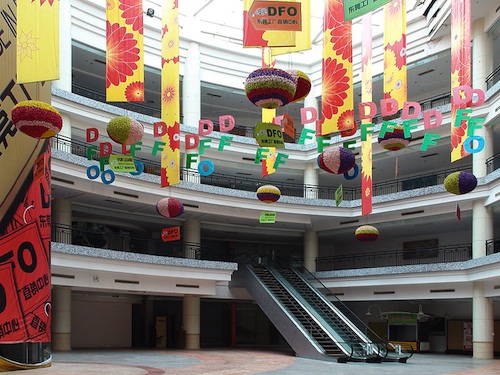A couple of months ago, a lot of people were passing around the news about China’s plan to create a megacity that would be home to 42 million people, the so-called “Turn the Pearl Delta Into One” idea. The reporting was generally favorable, painting a picture of economic growth and opportunity — the narrative of a prosperous China, with a growing middle class, that has become commonplace in recent years.
Unfortunately, the view of China’s urban planning strategies from the ground is less shiny. A riveting report from Dateline, an Australian TV show, reveals a disturbing pattern of development for development’s sake — the construction of gigantic infrastructure projects with no regard for human needs. (Hat tip to WalkableDFW.)
Take the New South China Mall, in Dongguan. The Dateline crew took a tour of the place, which has been 99 percent vacant since it opened in 2005, and the result is one of the most depressing things I have ever watched. Six years after its creation, what is touted as the largest mall in the world sits almost empty. One of the very few stores that’s in business is a toy shop, where the wistful owner spends his days dusting children’s bikes that no child will ever ride. He is lucky if he makes one sale a day.
And it’s not just that mall that sits empty. So do rows of massive skyscraper apartment buildings and central business districts in new cities around the country. This is at least part of the reality behind the megacities the Chinese are creating. “All the shops in this mall are empty,” says reporter Adrian Brown, walking down an immaculate but deserted street in one of the new cities, this one in north-central China. “Not that that worries the government, because they’re simply more concerned with maintaining economic growth, and one way of achieving that is building cities like this one.”
According to Hong Kong-based real estate analyst Gillem Tulloch, who is interviewed in the piece, the housing units are priced well above what an average Chinese person can afford. The result, he says, is a housing bubble that is terrifying in size, “a property bubble like which I don’t think we’ve ever seen,” he says. “It will make the United States pale in comparison. It’s said that there’s around 64 million empty apartments…. It’s essentially the modern equivalent of building pyramids. It doesn’t add to the betterment of people’s lives, all it does is it promotes GDP.”
As the Dateline report points out, there are indeed tens of millions of Chinese people who would like to own their own homes — but the urban development the government has backed is creating housing stock that is hopelessly out of their reach, even as it destroys old neighborhoods and cities at a feverish pace.
The potential result, as a Chinese sociologist points out, is a growing polarization of Chinese society — and the potential for civil unrest, as young people are increasingly marginalized and shut out of economic opportunity, and out of any kind of decent daily life, even as the numbers show a booming economy.
Back in 2009, filmmakers Sam Green and Carrie Lozano made a beautiful short film about the New South China Mall called “Utopia: Part 3.” It tells the story behind the mall’s construction: a local businessman who had gotten fabulously rich in the new Chinese market economy wanted to make his mark in the world by building something fantastic. No matter that the site, which was farmland, had no good access – by road or rail or any other conveyance.
[vodpod id=ExternalVideo.1011880&w=520&h=350&fv=video%3D1218530801%26player%3Dviral%26end%3D0]
Once the mall got built, it was “too big to fail,” and has been propped up by government-backed investors, a chilling example of useless infrastructure and wasted resources.
On the mall’s website, almost the only English words are “The New Urbanism City Life.” They appear under a stock image of two happy, young, apparently Caucasian people, leaping through the air.
But the mall, and similar planned, built-from-scratch projects, are in fact a grotesque distortion of “city life.” It is painfully difficult to imagine how any of them will become a real city, inspiring true love among those who live in it, fostering human connection and spurring innovation.
And yet around the globe, governments and business interests continue to build projects like these (see this report from pre-conflict Libya, for instance). They should look more closely at the Chinese example — beyond the GDP numbers to the bricks-and-mortar reality. Because when economic growth is pursued for its own sake, without regard to the needs and capabilities of the humans inside that economy, it is only a matter of time before the bubble will burst.


